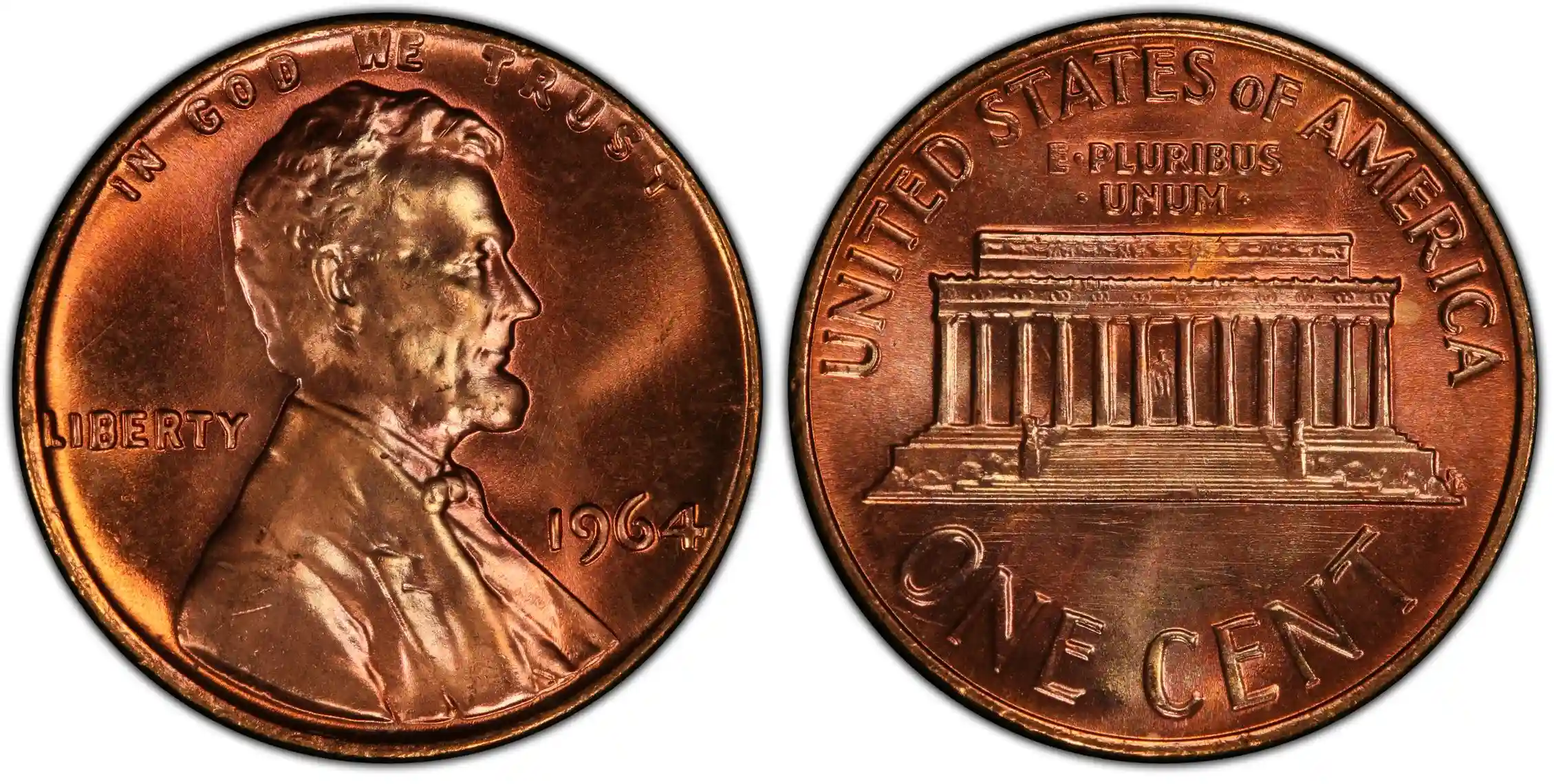
Coins both from Philadelphia and San Francisco look the same way as the mint mark wasn’t struck on them. Let’s now see how much is a 1964 penny worth with no mint mark.
| Grade | Price |
| MS-63 RD | $6 |
| MS-64 RD | $10 |
| MS-65 RD | $20 |
| MS-66 RD | $27 |
| MS-67 RD | $1,100 |
Melissa Adams is a programmer focused on developing apps for iPhone and Android. This blog is devoted to her special interest — coins and numismatics. Melissa is a collectionner and history lover, and in her articles she shares both collection insights and historical facts for enthusiasts. Stay tuned for more education on the go!




If you’ve ever sorted through your spare change and found a penny from 1964, you’re not alone. These coins are incredibly common—but before you toss it back into your jar, take a closer look. That small piece of copper could hold more value than you expect.
The 1964 Lincoln penny, also known as a wheat reverse memorial transition coin, is notable not just for its widespread availability, but also for the special traits some rare 1964 penny types carry. If you are keen on history or seeking for a treasure in your change jar — this article educates you on both topics.
Before we start exploring 1964 error penny varieties and some excessive price cases, let’s look at the most common types and see how much does a 1964 penny worth normally

Coins both from Philadelphia and San Francisco look the same way as the mint mark wasn’t struck on them. Let’s now see how much is a 1964 penny worth with no mint mark.
| Grade | Price |
| MS-63 RD | $6 |
| MS-64 RD | $10 |
| MS-65 RD | $20 |
| MS-66 RD | $27 |
| MS-67 RD | $1,100 |
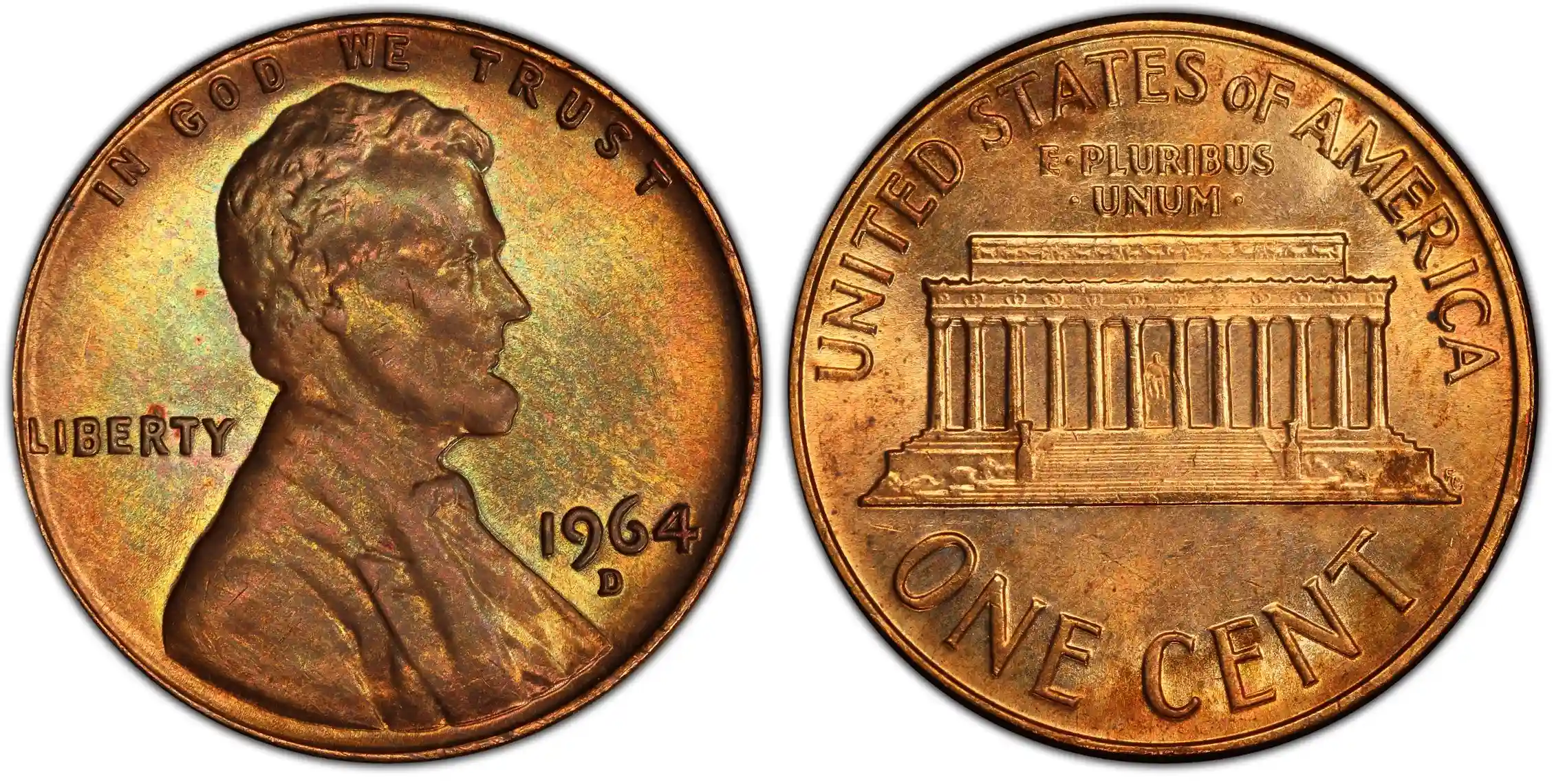
1964 D mint penny comes from Denver, and the general mintage was around 3,8 billions of coins. Here is a quick observation of the 1964 D penny value today.
| Grade | Price |
| MS-63 RD | $6 |
| MS-64 RD | $8 |
| MS-65 RD | $20 |
| MS-66 RD | $26 |
| MS-67 RD | $650 |
Early proof Lincoln cents were made to check the quality of coins. For the 1964 cents, there were about 4 million of such prototypes made, and a proof 1964 wheat penny value is a bit higher than for Denver or Philadelphia mints.
| Grade | Price |
| PR-64 RD | $8 |
| PR-65 RD | $10 |
| PR-66 RD | $10 |
| PR-67 RD | $20 |
| PR-68 RD | $26 |
| PR-69 RD | $45 |
| PR-70 RD | $2,350 |
If you are trying to figure out is a 1964 penny worth $10,000, here is the only possible answer — there is a tiny chance for it to be from a Special Mint Set. Unlike standard 1964 pennies minted by the billions for circulation, special strikes coins were never intended for public release. Value of 1964 penny of this type skyrocketed in comparison to others, according to auction records.
| Grade | Price |
| SP-61 RD | $1,500 |
| SP-62 RD | $1,800 |
| SP-63 RD | $2,650 |
| SP-64 RD | $6,000 |
| SP-65 RD | $11,500 |
| SP-66 RD | $15,000 |
| SP-67 RD | $18,500 |
| SP-68 RD | $27,500 |
During the early 1960s, the United States experienced a national coin shortage, driven by rising demand and hoarding of silver coins. In response, the U.S. Mint suspended Proof and Mint Sets starting in 1965 and instead produced Special Mint Sets from 1965 to 1967. These sets included one coin of each denomination and were struck with extra care to a unique satin finish—a texture that’s neither proof-like nor circulated in appearance.
But few people know that before this official SMS release program began, the Mint quietly created experimental SMS coins in 1964 to test this production approach. These coins bear no mintmarks and feature a finish unlike any other 1964 issue.
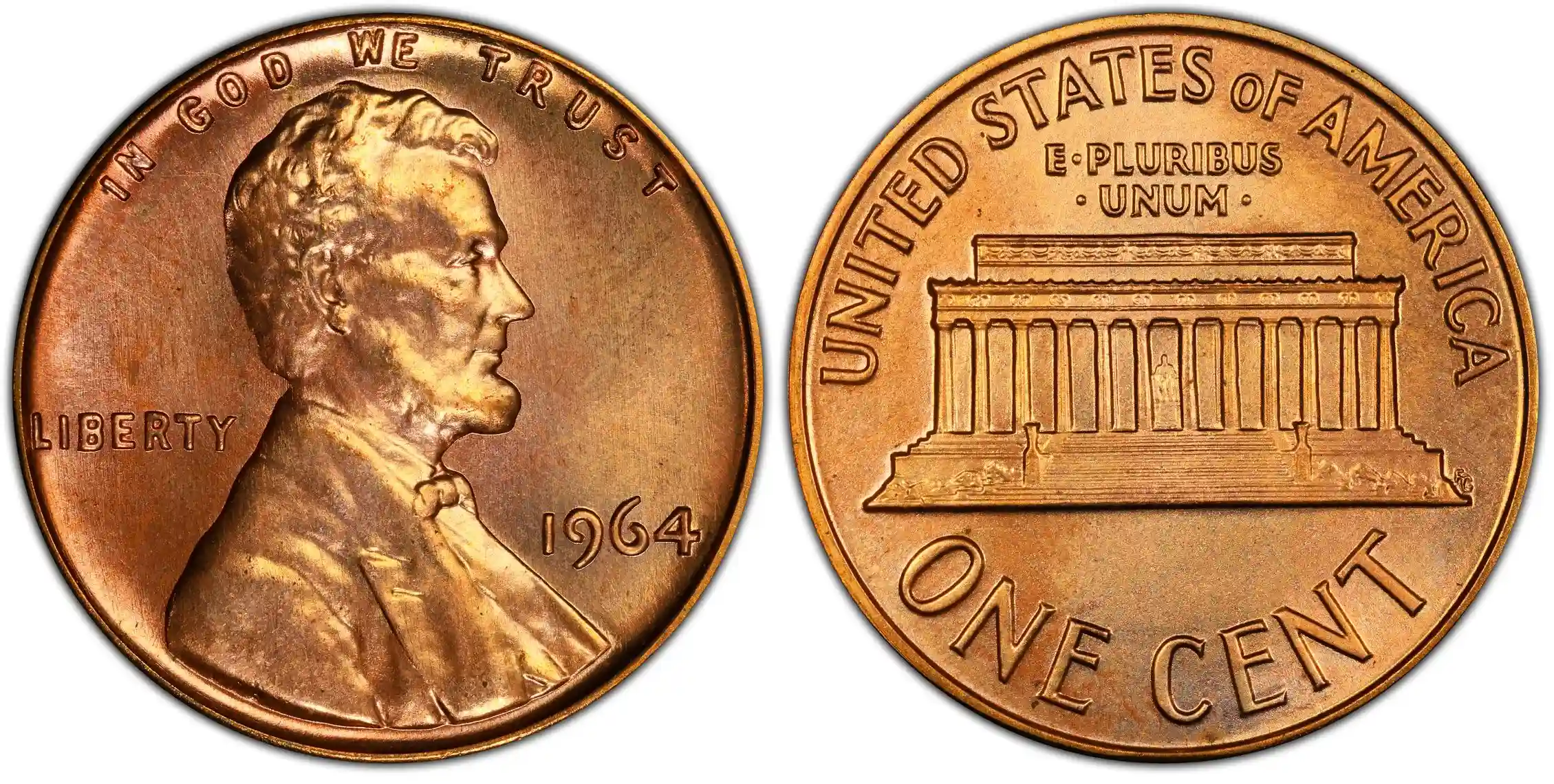
The 1964 SMS penny is distinct in both production quality and appearance. These coins are designated with the “SP” (specimen) finish by grading services due to their unique characteristics:
| Feature | Description |
| Surface Finish | Satin-like texture—neither mirror-like (Proof) nor dull (circulation) |
| Strike Quality | Sharper details, particularly in Lincoln’s hair and the Lincoln Memorial |
| Edge and Rim | Cleaner, more squared-off rims than circulation strikes |
| Mintmark | None—struck at Philadelphia, like other SMS coins |
| Designation | Graded as SP (Specimen) by PCGS and NGC |
These features are the result of special dies, polished planchets, and controlled striking environments—not found in mass-minted pennies.
For most people, a 1964 penny isn’t exciting. It’s not made of silver, it’s not especially old, and it’s not flashy. But here’s why it should get your attention:
This was the last year the U.S. Mint produced circulating coins with 95% copper before beginning to phase in coins with a higher zinc content. That alone gives it appeal for those interested in pre-1982 copper coins.
Because it’s a transitional piece—produced before major design or composition shifts—it draws attention from collectors. Some want a full run of Lincoln Memorial pennies. Others are focused on copper coin collections with unique mistakes or signs of time, so the 1964 penny value error gets higher each year.
The most valuable 1964 pennies are those in exceptional condition or containing mint errors—features that are often overlooked by casual collectors or coin hoarders.
So, how much is 1964 penny worth? Here are some examples:
The 1964 penny with no mint mark or with a D features President Abraham Lincoln on the obverse, a design first introduced in 1909 to celebrate the 100th anniversary of his birth. On the reverse, you’ll find the Lincoln Memorial, which replaced the original wheat ears in 1959. This reverse remained in place until 2008, when the U.S. Mint released a new design for Lincoln’s bicentennial.
In 1964, the U.S. Mint produced over 6.5 billion Lincoln pennies—making it one of the most minted coins in American history. Here’s a quick breakdown of the mintage:
| Mint Location | Mint Mark | Number Produced |
| Philadelphia | (No Mark) | 2,648,575,000 |
| Denver | D | 3,799,071,500 |
Despite this massive quantity, collectors still can seek out 1964 Lincoln penny no mint mark today—mainly due to rare errors, exceptional condition coins, and valuable varieties.
1964 Penny SMS Value1964 Penny SMS Value
You’ve got your hands on a retro coin from the 20th century! Let’s observe it and break down the key factors that influence how much your 1964 penny is worth.
The better the condition, the higher the chance to see the most valuable 1964 D penny value. Numismatists use a 70-point scale to describe condition:
Coins in MS-65 or higher, especially with original red luster, command premium prices.
Here’s a general breakdown of 1964 penny values based on their conditions and mint marks:
| Condition | 1964 (No Mint Mark) | 1964-D (Denver Mint) |
|---|---|---|
| Circulated | Face value to $0.10 | Face value to $0.10 |
| Uncirculated (MS60) | $0.20 – $0.50 | $0.20 – $0.50 |
| Gem Uncirculated | Up to $5+ | Up to $5+ |
| Error Coins | $10 – $250+ | $10 – $250+ |
Values can fluctuate based on the coin market and collector demand.
Copper coins age in three general color categories:
Copper coins naturally change color over time. The way they’ve aged—or haven’t—has a direct impact on how much is a 1964 D penny worth. Professional coin grading uses three categories to classify color on copper pennies:
| Color Grade | Description | Impact on Value |
|---|---|---|
| Red (RD) | Nearly full original copper-red coins | Most valuable – up to 3–5x more than brown versions |
| Red-Brown (RB) | Mix of red and brown toning | Moderately valuable |
| Brown (BN) | Fully toned brown | Least valuable unless rare or in high grade |
To preserve red tones, coins must be stored properly from the time of minting. That’s why RD coins in Mint State 65 or higher are rare—and command a premium 1964 penny value D.
While billions of 1964 Lincoln pennies were minted in the United States of America, only a small percentage is considered rare or highly valuable. The distinction comes down to mint errors, varieties, striking quality, and preservation. If you’re wondering ‘Is a 1964 penny worth anything?’, here are key signs of a possibly high quality coin.
Some 1964-D cents have subtle differences in design caused by worn or modified dies. These varieties are less dramatic than true mint errors but still attract collectors and raise 1964 no mint mark penny value.
Coins with sharp features, strong luster, and zero wear are rare simply because most pennies enter circulation immediately. Finding a pristine 1964-D cent with Full Red luster and MS67 or higher is rare—and some penny 1964 D value raised to $500 and more at auction.
The highest-value 1964 cents ever sold are those with a combination of factors—Red color, Mint State condition, and errors or varieties. Here are a few impressive examples of excessively high 1964 no mint penny value:
| Coin Type | Grade / Type | Auction Price |
|---|---|---|
| 1964 RD Lincoln Cent | PCGS MS67RD | $7,050 |
| 1964-D RPM Lincoln Cent | PCGS MS65RD RPM#1 | $253 |
| 1964 Doubled Die Obverse | ANACS AU58 | $165 |
| 1964 Clipped Planchet Error | Raw | $75 |
Prices fluctuate based on market demand, grading authority, and collector interest.
1964 penny errors are among the most exciting finds in coin collecting because they can transform an ordinary penny into a collectible item worth hundreds. Here are some of the most notable 1964 penny errors to look for (scroll to the next section to see a simplified table with all errors):
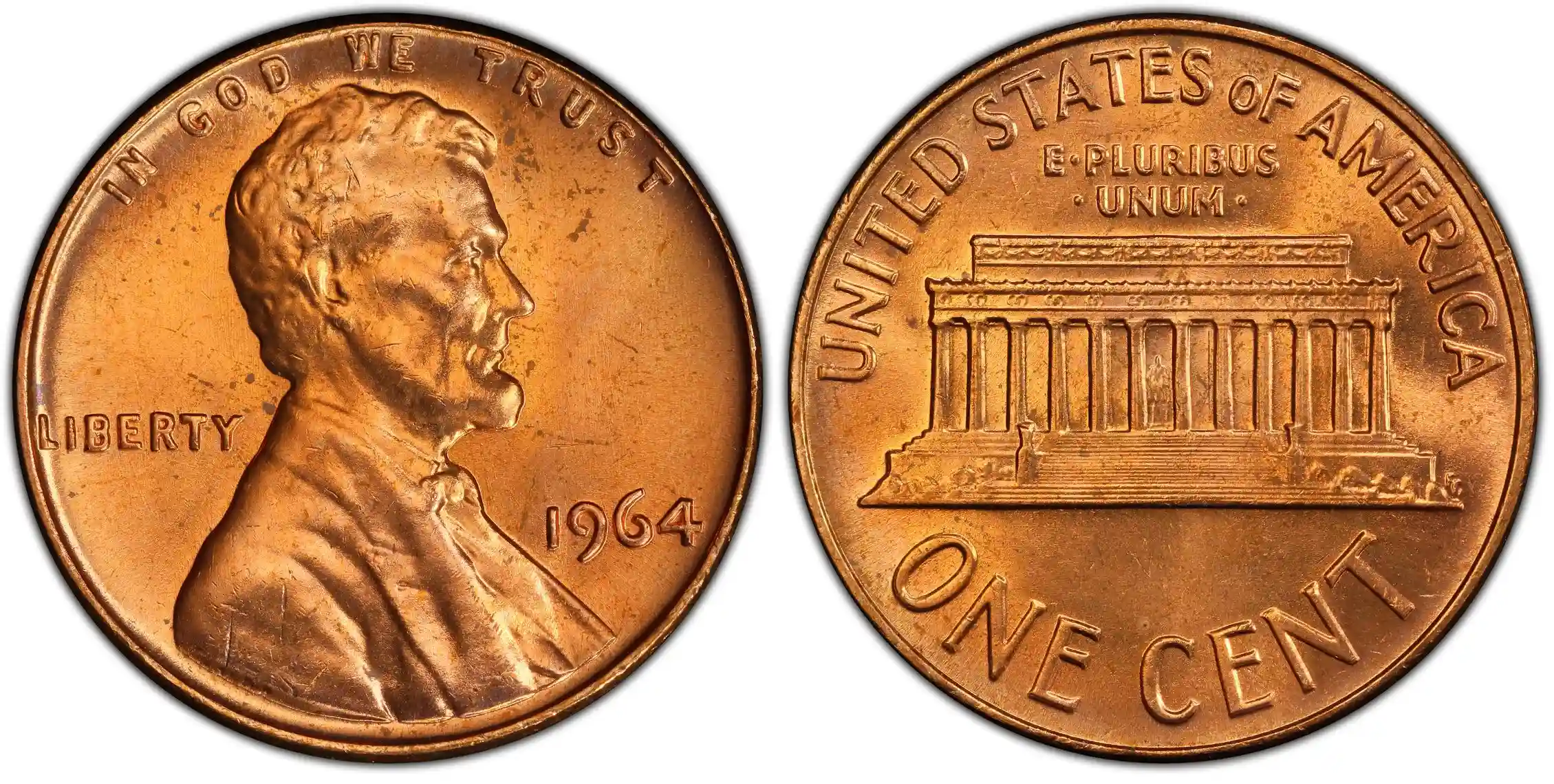
One of the most sought-after 1964 Lincoln cents. Doubling appears on the date, LIBERTY, or IN GOD WE TRUST. These errors are created when the die itself is incorrectly manufactured.

The design is not properly centered on the coin. The more dramatic the off-center error (especially those with date visible), the more valuable the penny struck.

A small die break between the letters “B” and “E” in “LIBERTY” creates what looks like a capital “I.” It’s minor but highly collectible among Lincoln cent enthusiasts.
Part of the coin is missing due to a faulty punch during the blanking process and being struck on the wrong planchet. These clipped coins are easy to spot by their irregular edges.
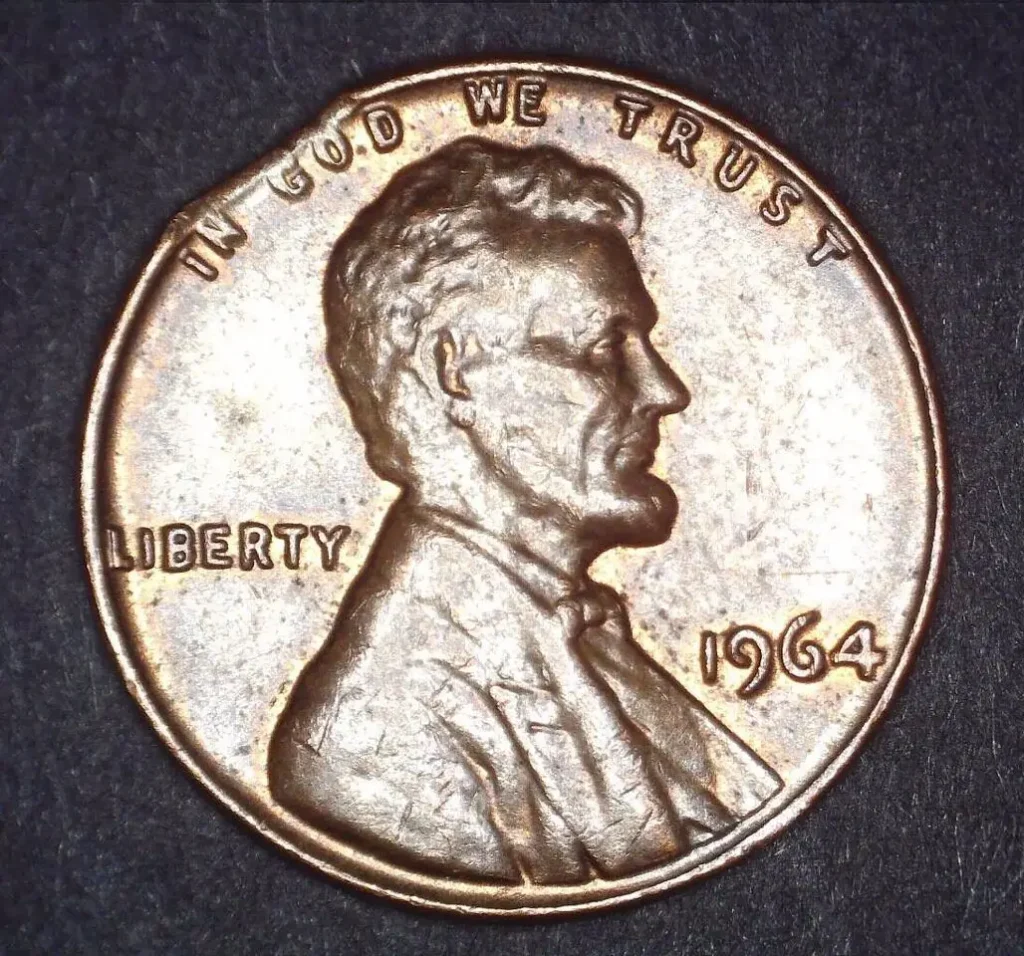
One of the most exciting aspects of coin collecting is discovering an error coin—a factory-made mistake that slipped through the U.S. Mint’s rigorous quality control. These flawed coins are not just curiosities; some are incredibly valuable. If you’re holding a 1964 penny and suspect it may be a rare error, here’s how you can identify what is a 1964 d penny worth like a pro.
Place your penny under natural light and slowly rotate it. You’re looking for anything unusual in the design:
Trust your eyes—many major errors are visible without magnification.
Take a quick look on this 1964 D penny error list while estimating the coin’s price.
| Error Type | What to Look For | Estimated Value |
|---|---|---|
| Doubled Die Obverse | Doubling of letters/numbers (especially date and “LIBERTY”) | $20 – $250+ |
| Off-Center Strike | Design not centered; higher value if date is still visible | $10 – $150+ |
| BIE Error | A raised vertical line between the “B” and “E” in “LIBERTY” | $5 – $25 |
| Clipped Planchet | Curved or straight portion of the coin is missing from minting process | $10 – $60+ |
| Repunched Mint Mark | A second “D” slightly offset or layered over the first | $15 – $75+ |
| Die Crack or Cud | Raised lines or blobs where the die broke during minting | $10 – $80+ |
To go beyond the basics, consider these tools:
For collectors who want to be sure is a 1964 d penny worth anything, the Coin ID Scanner app is a reliable tool. Just snap a photo of your coin, and the app compares it against a database of over 150,000 coins to instantly provide:
It’s especially helpful if you’re new to numismatics and want to verify coins quickly without costly third-party grading.
If you have multiple 1964 pennies, place them side by side:
Sometimes, the best way to spot an error is by seeing what shouldn’t be there.
If you suspect your penny is rare but need confirmation:
The 1964 Lincoln penny may be one of the most common coins in circulation, but hidden among the billions are valuable gems—rare errors, high-grade examples, and standout varieties that collectors actively seek. Whether you’re holding a bright red Mint State coin or a quirky off-center strike, there’s potential value in your hands.
By understanding what to look for—mint marks, condition, color, and errors—and using tools like the Coin ID Scanner app, you can confidently identify and evaluate your finds. So before you spend that old penny, take a closer look—it might just be worth far more than one cent.